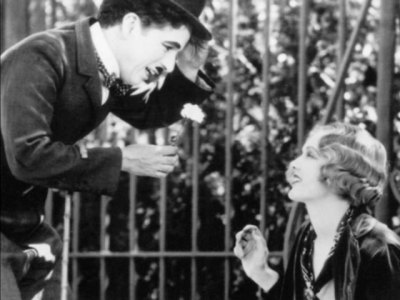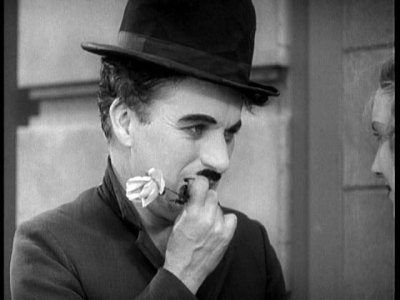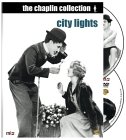| Reviews & Columns |
|
Reviews DVD TV on DVD Blu-ray 4K UHD International DVDs In Theaters Reviews by Studio Video Games Features Collector Series DVDs Easter Egg Database Interviews DVD Talk Radio Feature Articles Columns Anime Talk DVD Savant Horror DVDs The M.O.D. Squad Art House HD Talk Silent DVD
|
DVD Talk Forum |
|
|
| Resources |
|
DVD Price Search Customer Service #'s RCE Info Links |
|
Columns
|
|
|
City Lights (2 Disc Special Edition)
 The movies changed forever in 1927 when The Jazz Singer was released. Vaudeville star Al Jolson took the country by storm when he sang in this first talking picture. (There had been other movies released with sound tracks, but this was the first that was widely distributed, and had a system for synchronization that worked well.) The public wanted to hear the starts talk, and Hollywood was in an uproar. Films that were already completed were re-shot to add sound, and projects that were in the pipeline were scrapped. Silent comedians started making movies where they had a lot of dialog, and the art of slapstick all but died.
The movies changed forever in 1927 when The Jazz Singer was released. Vaudeville star Al Jolson took the country by storm when he sang in this first talking picture. (There had been other movies released with sound tracks, but this was the first that was widely distributed, and had a system for synchronization that worked well.) The public wanted to hear the starts talk, and Hollywood was in an uproar. Films that were already completed were re-shot to add sound, and projects that were in the pipeline were scrapped. Silent comedians started making movies where they had a lot of dialog, and the art of slapstick all but died. Not everyone was happy with the transition to sound of course, and in a lot of ways adding sound to the movies was a giant step backwards. The camera no longer moved as it did in such films a The Last Laugh. It was stationary so that the microphones wouldn't catch the sound of the cameraman moving. Actors couldn't move as they once did, they had to stay close to the mic to keep the sound level constant. It was considerations such as this that caused silent star Mary Pickford to comment "It would have been more logical if silent pictures had grown out of the talkie instead of the other way around."
But not everyone jumped on the sound bandwagon. Although Laurel and Hardy, Buster Keaton, and Harold Lloyd all started making talking pictures, Charlie Chaplin didn't. This wasn't because he was afraid of the new technology, or that he had a funny sounding voice. He just thought that silent movies were superior to talkies for certain subjects, comedy being one of them.
This was very controversial at the time. Just about everyone thought that the public would no longer pay to see silent movies. Undeterred, Chaplin decided that he would continue to make them.
For his next project, City Lights, Chaplin started looking for an unknown to play his leading lady. Chaplin didn't like working with experienced actresses, he was looking for someone who would play the part the way he wanted it played. He felt that a trained actress wouldn't always follow his directions. His discovery for this film was a young recent divorcee, Virginia Cherrill.
Though Cherrill had no acting experience, she and Chaplin did not get along. Chaplin complained that she wasn't taking the movie seriously enough, and she thought he was too much of a perfectionist. In the scene where the two meet at the beginning of the movie, Chaplin insisted on retaking the shot where she hands him a flower over 300 times!
There was just too much friction between the two. After over a year of shooting, their animosity finally reached a pinnacle and Chaplin fired her. He started testing new actresses, including Georgia Hale, his leading lady from The Gold Rush. But the production had already been a long and costly, and to reshoot virtually the entire movie would have been too much. Reluctantly, Chaplin rehired Virginia and finished the film.
When the movie was completed in October of 1930, after nearly two years of filming, the motion picture industry had changed too much for it to be released. Silent movies were dead, and theaters no longer had orchestras or even piano players to accompany the films. So Chaplin decided to compose a score for the movie himself, and have it recorded as the soundtrack.
Chaplin had made a point of not looking at the cost of the movie while it was in production. When it was completed he was astonished to discover that he had spent an astonishing 1½ million dollars on the film. Without expensive locations or a star leading lady, the money had been eaten up by his incredibly long shooting schedule. Though he had to pay his cast and crew for a total of 22 months, he only ended up shooting film for 179 days.
To recover his costs, he raised the ticket price to $1.50. There was a lot of doubt whether people would pay that much for a silent movie, and Chaplin was worried. At a sneak preview of the film, many of the viewers seemed confused, and several walked out.
The movie premiered on January 30, 1931 in Los Angeles, and Chaplin was prepared for the worst. The theater was filled with stars and Chaplin's special guests, Mr. and Mrs. Albert Einstein. He needn't have worried. The reception was very enthusiastic, both at the premier and across the country. The public flocked to see the film, with one theater in New York running the show continuously from 9 am until midnight. Chaplin's net for the city of Paris alone covered the cost of production. City Lights was Chaplin's greatest masterpiece.
The Movie:
 The plot is elegant in its simplicity: The Tramp buys a flower from a beautiful girl. She is blind and has mistaken the Tramp for a very wealthy man. The Tramp is enraptured with her beauty and falls in love. Though blind, the girl can see the Tramp's noble spirit and feels for him too. The Tramp puts all his effort into getting the money she needs for an operation to restore her eyesight. But will he be able to raise the fantastic sum? And if he can, how will she react when she finally sees the Tramp as he really is?
The plot is elegant in its simplicity: The Tramp buys a flower from a beautiful girl. She is blind and has mistaken the Tramp for a very wealthy man. The Tramp is enraptured with her beauty and falls in love. Though blind, the girl can see the Tramp's noble spirit and feels for him too. The Tramp puts all his effort into getting the money she needs for an operation to restore her eyesight. But will he be able to raise the fantastic sum? And if he can, how will she react when she finally sees the Tramp as he really is?
This film is Chaplin's most perfect work. The story is very simple, and extremely effective. At its heart, it is a charming love story, but Chaplin manages to fill the romance with an incredible array of sight gags. Humor fills the show, but it never loses its intimacy.
The movie's pacing is near perfect, with the story flowing very easily. A good example is the scene where the Tramp falls in love with the girl. She hears a car drive off, and thinks that he has left. The Tramp sits on a bench and just stares at her, as she washes out her pail. Her beauty mesmerizes him, yet he knows that he, a mere tramp, could never have her. As she finishes washing, she throws the dirty water in the Tramps face, not realizing that he is there. This simple gag's set up is transparent, you are focusing on the romance, and don't even see the joke coming. It also serves to lighten the mood and is an effective way to end the scene. Humor and pathos mix brilliantly to create a moving and funny scene. The entire movie flows like that. The plot builds slowly, almost invisibly, with humor and emotion, until the climax at the end.
There are a lot of movies that have really good endings: Citizen Kane, The Usual Suspects, and Casablanca are all much stronger films because of their well crafted finales. But in my opinion, the end of City Lights is the best finish that any movie ever had. The way Chaplin molds the viewer's emotions is nothing short of genius. It is a great ending to a fantastic film.
The DVD:
This movie was mastered from a PAL video source and converted to NTSC. What does this mean? It means that the film runs 4% faster than it should. The pitch seems to have been corrected on the soundtrack, but the playing times are still 4% shorter than they should be. This is very unfortunate, but not a huge deal. About the only way to notice the difference is to check the run times, the slight speed up is not noticeable to the casual viewer. Even someone familiar with the movie would be very hard pressed to see the difference, it is very slight. Another reason that this in a non-issue is that silent movies did not have a standard film rate. It wasn't until sound movies arrived that projection speeds were standardized. (That's why silent movies are always measured in reels of film and not the length of time it took to show them.) Sometimes the distributor would even send notes with the films instructing the projectionist to run certain scenes faster or slower. So the fact that these are 4% faster than an arbitrary 'silent speed' should not be a large factor when deciding whether or not to purchase this set.
Audio: There is a choice of the original mono track, or a 5.1 mix. The 5.1 mix was a little more open, but not to a huge degree. Both sounded very good. The audio is clean and bright, with no distortion or audio defects. It suits the movie perfectly. There are subtitles in French, Spanish, Portuguese, Chinese, Thai, and Korean.
Video: This transfer is beautiful. The full frame picture is clean and clear, with crisp lines and fantastic detail. The encoding is excellent, with digital artifacts being almost nonexistent.
It is had to believe that this film is over seventy years old. I doubt you will ever see this film look any better.
Extras:
As with most of the other Chaplin movies that WB has released, this DVD is chocked full of extras!
Introduction by David Robinson (5 min): The Chaplin biographer gives a short overview of Chaplin's life at the time he made City Lights, and recaps the movie. A nice brief overview putting the movie in context of Chaplin's life.
Chaplin Today: City Lights (26 minutes): Another in a series of featurettes about each of Chaplin's films. This time Peter Lord, from Wallace and Gromit fame, analysis the movie and talks about why it works so well.
Outtake (10 min): A scene that was removed from the film before its initial release. A funny scene where the Tramp tries to remove a stick lodged in a grate with his cane. The scene is excellent, but Chaplin felt that it interrupted the flow of the story so he cut it.
The Champion (10 min): An excerpt from Chaplin's 1915 Essanay movie that has a fight scene similar to the one in City Lights. I would have much preferred the entire movie rather than this extended section, but it is still fun to watch.
Shooting (8 min): Alternate takes from the scene where Charlie and the flower girl first meet.
Georgia Hale screen test (7 min): Near the end of the production, Chaplin fired co-star Virginia Cherrill and tried to find a replacement for her. He auditioned his leading lady from The Gold Rush and this is the screen test he gave her.
The Dream Prince (1 min): A discarded scene where the flower girl imagines her benefactor.
Rehearsal (1 min): A short bit where Chaplin works out the staging for a scene.
Chaplin and Boxing Stars (4 min): Chaplin hamming it up with boxing stars.
Winston Churchill's Visit (2 min): The famous British statesman (before he was PM) visits the set of City Lights.
Chaplin Speaks (3 min): Chaplin talking to a newsreel reporter in Vienna during a tour of Europe. This is the first time Chaplin spoke on film.
Trip to Bali (10 min): Charlie and Sydney Chaplin in Bali in 1932.
Photo Gallery: Some production stills from the movie.
Film Posters: A selection of movie posters advertising City Lights from all around the world. It includes original releases and re-issue posters.
Trailers (8 min): A collection of trailers promoting City Lights.
Chaplin Collection (12 min): A selection of scenes from each of the movies in the Chaplin Collection.
These extras are a great bonus! Clips of this footage have been shown in various Chaplin documentaries and specials over the years, and it is great to see the whole piece instead of a few seconds. Sure to please any Chaplin fan.
Final Thoughts:
This DVD is a no-brainer for me. City Lights is a masterpiece, and this DVD has a beautiful transfer and a bonus disc filled with great extras. This is a must for any serious film collection. DVD Collector's Series.
|
| Popular Reviews |
| Sponsored Links |
|
|
| Sponsored Links |
|
|
| Release List | Reviews | Shop | Newsletter | Forum | DVD Giveaways | Blu-Ray | Advertise |
|
Copyright 2024 DVDTalk.com All Rights Reserved. Legal Info, Privacy Policy, Terms of Use,
Manage Preferences,
Your Privacy Choices | |||||||













